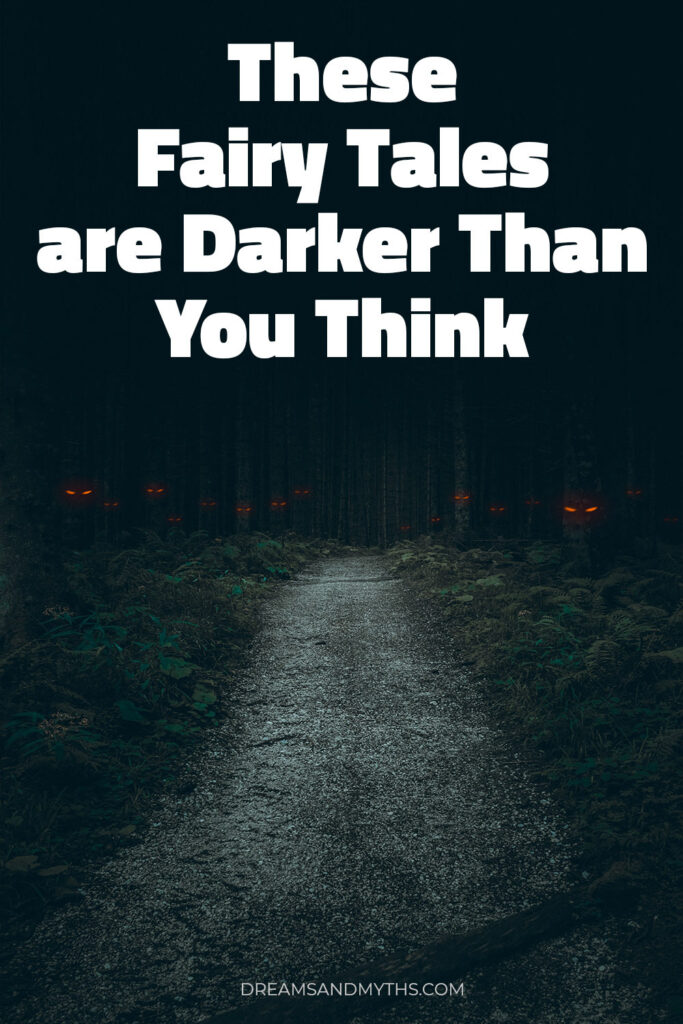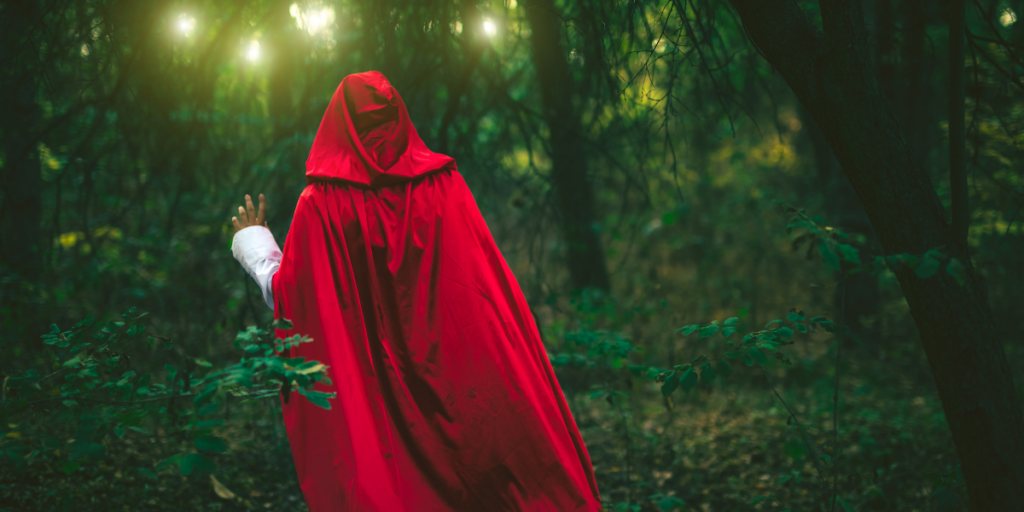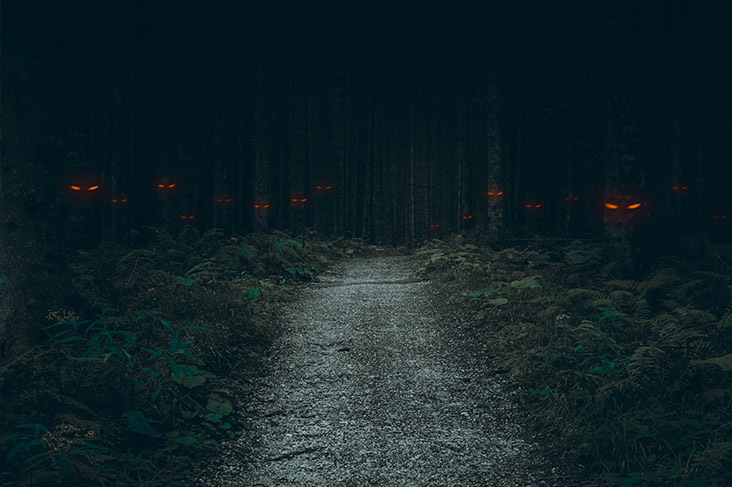These fairy tales will make you question your childhood. The innocent bedtime stories we grew up with are in fact much darker than you think. In this blog post, we’re going to explore the raw, original version of fairy tales. How and why they were transformed into what we know today as kid’s stories.
Do people tell stories anymore? I’m not sure.
I fear that between Netflix, YouTube, and TikTok the art of storytelling and mythmaking has been lost – at least to a degree.
Of course, these modern mediums have their place. Yet, some of the most precious memories from my childhood weren’t looking at a screen. It was the memory of me all snuggled up under my sheets or near the fire, and my grandparents telling me a story.
You know what I’m talking about…
These weird tales that didn’t make sense at that time but for some reason, you couldn’t stop listening. They were our first interaction with the concept of “myth” in its purest, unfiltered form.
The true essence of the fairy tale has to do with the internal structure of our psyche and how it relates to the world around us. I talk about this more here.
What’s interesting is how modernity transformed the way we interact with reality. And this is obvious if we consider how the stories we tell ourselves change over time.
The Dark Unconscious

OK, let’s do an experiment. Think of a fairy tale. Doesn’t matter which one.
Now, remove the flowery language and the filter of your parents. What’s the story really about?
If you dig deep, you’ll realize that almost all of them hide a disturbing nature, infused with a surreal vibe; the sense of “something is wrong”.
Don’t worry if you can’t see right away. I’ll expand with concrete examples in a minute. But the point I’m trying to make is that, for the most part, these fairy tales try to articulate something we aren’t consciously aware of.
And the only way we’re able to translate it into a human language is through images and symbolism.
It’s the same feeling you get when there’s a storm outside. When you walk down a dark alley. When you hear a sound deep in the woods. When you look at a wolf or dive in the ocean.
It’s the incomprehensible feeling of existence itself that arises in the early hours of the morning.
That’s the unconscious mind. The primal part of your brain that’s still connected with nature. No matter how “advanced” we believe we are, it’ll always find a way to emerge.
But there’s an issue when we actively avoid it.
Stop Hiding From Your Nature
Jung talks about how if we attempt to shy away from our “shadow”, it’ll find ways to manifest in our lives in catastrophic ways.
If we apply the same logic on a larger scale, then we can see how the 20th century has been a perfect example of this “loophole”.
But I digress. The important thing to understand is that the nature of the fairy tale changed to accommodate our desire to hide from the ugly aspects of ourselves.
We removed the unsavory parts and transformed them into children’s stories. We hid violence, unapologetic nature, tribalism, jealousness, etc under the rug pretending it was never here.
Having said that, one of the goals of D&M is to bring mythology – and that includes fairy tales as well – back into reality. By revealing the original purpose of the Märchen, we might be able to reveal the true (forgotten) nature of humans.
After all, as I’ve already mentioned, how we structure the stories we tell ourselves is how we structure our lives!
3 Dark Fairy Tales to Keep You Up at Night

I still remember my mother’s face when she reached the middle of the story. She couldn’t believe that a children’s fairy tale could be so traumatic!
She quickly closed the book and placed it in our library. It was the Grimm Brother’s fairy tales, and like most people, she thought it was another collection of short stories about kids.
Yet, it contained the real version of fairy tales. Tales that weren’t intended for children.
(Interesting fact: The brothers wrote that collection as part of research to be shared with other folklorists, not children)
Some of them go back thousands of years, while others were developed alongside an everchanging culture.
1. Hansel and Gretel
Summary from Wikipedia:
“Hansel and Gretel are a brother and sister abandoned in a forest, where they fall into the hands of a witch who lives in a house made of gingerbread, cake, and candy. The cannibalistic witch intends to fatten the children before eventually eating them, but Gretel outwits the witch and kills her.”
Everyone knows this one. The warning “don’t take candy from strangers” rings any bells?
While it’s the Grimm brothers that pieced together the plot, its origins stem from the late middle ages. Yet, the themes and symbolism might have roots in a proto-indo-european coming-of-age tradition and the rite of passage to adulthood.
The Dark Side:
What most people don’t know is that the two kids were abandoned after the stepmother convinced their father to leave them in the forest because they had no food to spare.
While the malevolent stepmother enters the picture during the last iterations of the story, the concept of abandonment and escaping home – only to encounter dangerous strangers – is an important theme of the story.
But using their wits, they’re able to return to the hearth of the family. Some argue that the candy house is a representation of the oral fixation young kids overcome as they enter puberty. Or, rather, a separation of identity from the Mother archetype and the formation of individual psychology.
At the end of the story, Gretel traps the Witch in the oven, saying: “The ungodly witch to be burned in ashes”, reminiscent of the burning of the witches a couple of hundred years ago.
The kids also steal her treasure!
As you can see, cannibalism, abandonment, burning your victims alive create a completely different picture of this beloved fairy tale…
2. Little Red Riding Hood

Summary: A girl wearing a red cloak is bringing sweets and treats to her grandmother, outside the village. A big bad wolf stalks her like prey, hiding behind tall trees and patches of grass. Eventually, he approaches and tricks her into telling him where she’s going. The wolf runs first to the grandmother’s house and, pretending to be the girl, he enters and eats her whole. The little girl arrives and the wolf eats her as well. Eventually, a huntsman comes along and saves the two women. He cuts open the wolf and fills his belly with rocks. When the wolf tries to escape, he’s weighed down by them, eventually dying.
“Goodness, what big eyes you have!”
“The better to see you with”
There are many little details that add enormous depth to this story. While it was written in the 17th century, there’s speculation it’s a retelling of a much older version going back to at least the 10th century.
The antagonist wasn’t always a wolf. Sometimes it was human, ogre or in Eastern versions, a tiger.
The Dark Side
What seems like a very tame pedagogical fable about the dangers of talking to strangers is a rather twisted story about sexuality, with larger mythological themes in the background.
First of all, in the original version, the mother is very explicit about “following the path”, contrasting the safety of the village (community) compared to the dangers lurking in the forest.
Yet, the little girl refuses to listen and mingles with the genius loci, admitting her wild nature.
The act of the wolf eating the girl has two different interpretations, depending on the cultural context of that time. One is supposed to avert young women from sexual promiscuity. The other describes rape and the trauma that can potentially “swallow your soul” as well as your body.
The Red Cape is also intentional. It’s supposed to represent the Sun getting swallowed by the Night, the wolf. It represents the cyclical rhythm of nature, the duality of summer and winter.
On a deeper level, in Norse mythology, it’s said that during Ragnarok the wolf Skoll will swallow the sun whole!
The escape of the girl from the belly of the beast is the May Queen escaping winter. Instead of a crown of flowers, she’s wearing her red cape.
3. Rapunzel
Summary: The cravings of a pregnant woman forces her husband to steal a root vegetable called rapunzel from the lot of a witch. One night, she catches him and accuses him of stealing. The only way to not punish the couple is by giving away their baby. Which they did. The old crow puts her on a tower with no stairs or doors. Every day the witch shouts:
Rapunzel!
Rapunzel!
Let down your hair
That I may climb thy golden stair
A prince notices this and decides to save Rapunzel!
The archetypal “Maiden in the Tower” story can be tracked down to ancient mythology. The myth of Princess Danae, mother of Perseus being locked inside a bronze tower by Acrisius, the King of Argos. Or the daughter of Balor, Ethniu from Irish mythology.
The life of St Barbara of Nicomedia brings myth to life, though the validity of her story is questioned.
The Dark Side
The young prince is tricked by the witch. To escape, he jumps off the window, falling into a bush of thorns that blinds him. Wandering around for years, he hears the song of Rapunzel who, in the meantime, gave birth to twins. They’re reunited and her tears heal his eyesight.
You’ll notice that these folklore tales play with themes of purity and protection from pre-marital relationships. Specifically, Rapunzel describes the unfortunate relationship between a young woman and her zealous guardian, usually a spinster crone.
The fantasy of a prince saving her from a boring life trapped in the confinement of a small village is a common expression of moving up the social ladder and escaping the lower class. And the only way to do that back then was through marriage.
True to that, in the end, we see the woman liberated, inheriting a kingdom and fulfilling her fantasies.
The rebellion against the authoritative figures in her life showcases the desire of the oppressed to oppose traditional power structures that keep them “enslaved” – both morally and physically.
Some claim that this fairy tale goes back to a matriarchal myth from old PIE religions that has been now lost.
“They Lived Happily Ever After”
“Until there came to them the One who Destroys all Happiness”, says One Thousand and One Nights.
While it’s true that most fairy tales have a happy ending or at least a satisfactory conclusion, the theme of transformation isn’t absent.
The protagonist goes through a symbolic death, following the blueprint of the monomyth. And that’s as important as the sobering realization of death.
Because like Chesterton said:
“Fairy tales do not tell children the dragons exist. Children already know that dragons exist. Fairy tales tell children the dragons can be killed”
P.S. There’s going to be a part 2. Let me know which fairy tales you want me to analyze next.
